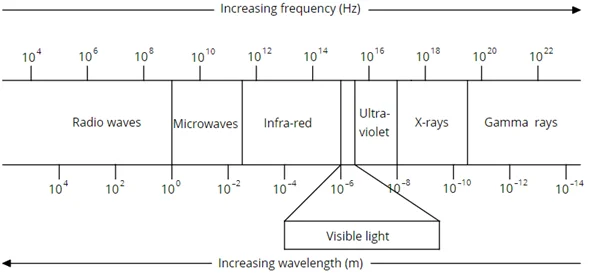Electromagnetic Spectrum
In today's article, we will learn about the electromagnetic spectrum, the order and properties of the individual electromagnetic waves. We will learn:
- To understand the order of the electromagnetic spectrum, the seven components of the electromagnetic spectrum.
- To understand the properties of electromagnetic waves.
- To know the applications, effects, and possible hazards of the individual electromagnetic waves.
The article is written to help the students studying the Secondary 4 Physics coursework.
Order & Properties Of Electromagnetic Waves
Electromagnetic waves are a spectrum of seven waves:
- Gamma Rays - It has the shortest wavelength and highest frequency.
- X-Rays - Commonly used to analyse cracks in bones.
- Ultraviolet Rays - Ultraviolet rays result in tanning of our skin and may cause skin cancer.
- Visible light - Our eyes are able to detect light in the visible light range and thus visible light helps us see things around us. It covers 10% of the whole electromagnetic spectrum. Visible light consists of a range of visible colours from violet to red. Ultraviolet radiation lies beyond violet colour, and infrared radiation lies just beyond red colour.
- Infrared radiation - They are given out in the form of heat.
- Microwave radiation - Waves emitted in the microwave oven that allows the cooking of food.
- Radio waves - Waves that are responsible for transmission of data for radios and televisions. It has the longest wavelength and lowest frequency.
\(\text{V}= \text{f }\lambda\) is the formula for the velocity of the electromagnetic spectrum.
From here, we can see that frequency is inversely proportional to wavelength.
The order of electromagnetic waves can be arranged in terms of order of wavelength or frequency.
The order given below is in terms of decreasing wavelength (or increasing frequency):
Radio wave
Microwave
Infrared
Visible light
Ultraviolet
X-rays
Gamma Rays
Components of Electromagnetic Spectrum

Gamma and X-rays are highly dangerous. They can cause mutations in our cells.
Our handphones use radio waves which are not hazardous to our health. Radio waves have low energy levels and would not cause cancer.
Infrared rays, radio waves, microwaves, and visible rays are not hazardous to our health.
Question 1:
Which of the following is not an electromagnetic wave?
- Radio wave
- Ultraviolet
- X-rays
- Ultrasound
Solution:
D) Ultrasound
Explanation:
Ultrasound is different from ultraviolet. It is not a part of the electromagnetic spectrum. Thus, the answer is: D). Ultrasound
Properties of Electromagnetic waves
- Electromagnetic waves are transverse waves.
A transverse wave is a wave in which the wave vibrates in a direction that is perpendicular to the direction of the motion of the wave.
- Electromagnetic waves can travel in vacuum.
From the Sun to Earth, there is only vacuum in space. Electromagnetic waves can propagate from the Sun to Earth because they can travel in vacuum.
- All electromagnetic waves travel at the same speed (3× 108 m/s ) in vacuum.
All electromagnetic waves travel at the speed of 3 × 108 m/s in vacuum.
- They transfer energy from one place to another.
- The wave speed equation \(\text{V}= \text{f }\lambda\) applies to all electromagnetic waves.
All the electromagnetic waves follow the wave speed equation. Note that the speed of 3 ×108 m/s only applies to the waves in vacuum.
- They do not carry any charges.
Electromagnetic waves do not carry charges and thus not affected by electric fields.
- They obey the law of reflection and refraction.
Applications & Effects of Electromagnetic Waves
Gamma Rays
- These have the highest frequency and hence are high-energy rays that can kill living cells.
- They are used in radiation therapy and sterilization of equipment.
Radiation therapy uses gamma rays for cancer treatment.
Sterilization kills off microorganisms from the equipment and reduces the risk of infection from the use of the equipment.
X-rays
- X-rays are high-energy rays that can damage DNA of a cell.
- They are used in radiation imaging, sterilization, and detection of flaws in heavy metal equipment. Bacterial cells can be killed using X-rays.
- X-ray of hands or any parts of our body helps to detect any internal damage in our body.
X-rays can be used to detect the break in heavy metals. But how do they do it?
There is a source of X-rays and the rays are allowed to pass through the metal. If a high amount of X-rays is detected by the detector, we can confirm a crack in the metal.
X-rays are considered dangerous and X-ray imaging are usually not done on pregnant women as the X-rays could damage the foetus in the womb.
One damaged cell will duplicate into 2 other cells which are damaged, and then these 2 cells will duplicate into 4 other cells. In this manner, damaged DNA in the foetus (and baby) is passed on.
Ultraviolet Rays
- UV radiation could lead to sunburns and skin cancer.
- They are used in sun beds and for sterilization of equipment.
- UV- A, UV-B, and UV-C are three types of Ultraviolet radiation.
Visible Light
- It allows us to see the world around us.
- They are commonly used in optical fibres.
Why is our internet so fast?
The fast speeds of the internet are possible because we make use of optical fibres. These use light to transfer signals and that is why our internet speed could be so fast.
Infrared
- They are given out in the form of heat (thermal). All the objects above 0 K (- 273°C) give out infrared radiation.
- They are used in remote controllers, ear thermometers, and intruder alarms. You can feel the presence of heat on the front side of the remote Television. Those are the infrared radiations.
Microwave
- They are used for satellite communications because they can penetrate into the atmosphere.
- They are used in microwave ovens, satellite television, and Global Positioning Systems (GPS).
Microwaves have higher energy levels than radio waves. Microwaves can penetrate the atmosphere, but radio waves cannot.
If you want to watch TV from another country, you would need to receive the signal through satellite via the transmission of microwaves.
Microwaves can cook food. When water molecules absorb microwaves, water molecules vibrate vigorously. The kinetic energy of the molecules increase, allowing the temperature of the food to rise.
Radio Waves
- Radio waves have the longest wavelength in the electromagnetic spectrum.
- They can travel around obstructions better than those of shorter wavelengths.
- They are used in radios, over-the-air television, and communication.
When you watch TV in a closed room, your TV can still receive signals via radio waves. Radio waves can also penetrate underground, allowing the use of mobile phones underground.
Over-the-air television shows the channel from the local channels and not overseas channels since radio waves are unable to travel long distances.
Effects Of Electromagnetic Waves
- X-rays and gamma rays can knock out electrons and ionize the particles in their path.
- Exposure to ionizing radiation can damage biological molecules and lead to abnormal cell division.
- This may cause mutations in the cell and lead to cancer.
Question 2:
Do gamma rays have a higher speed than radio waves when travelling in a vacuum?
- Yes
- No
Solution:
B) No
Explanation:
They travel at the same speed and time. All the electromagnetic waves travel at 3 × 108 m/s.
Question 3:
The velocity of radio waves is 3 × 108 m/s. A radio station is broadcasting at a frequency of 1 × 106 Hz. What is the wavelength of the radio waves?
- 100 m
- 200 m
- 300 m
- 400 m
Solution:
C) 300 m
Explanation:
We have, \(\text{V}= \text{f }\lambda\)
Given V = 3.0 × 108 m/s and
f = 1 × 106 Hz
So,
3.0 × 108 = 1 × 106 × λ
λ = 300 m.
So, the correct answer is: 300 m.
Question 4:
State the type of electromagnetic waves used over the air television.
- Radio waves
- Microwaves
- X-ray
- Gamma rays
Solution:
A) Radio waves.
Question 5:
State the type of electromagnetic waves used in Satellite Television.
- Radio waves
- Microwaves
- X-ray
- Gamma rays
Solution:
B) Microwave.
Question 6:
State the type of electromagnetic waves used in medical imaging.
- Radio waves
- Microwaves
- X-ray
- Gamma rays
Solution:
C) X-ray.
Conclusion
In this article, we learned about the seven components of electromagnetic waves. We studied the order of the spectrum and the frequencies and wavelengths. We also learned about the different properties of the waves and discussed how they are used in our daily lives.
We also saw the effects that the waves can have on different substances and humans. The article covers details as per the Secondary 4 Physics class.
Keep learning and study well!
| Continue Learning | |
|---|---|
| Electromagnetic Spectrum | Sound |
| Static Electricity | D.C. Circuits |
| Electromagnetic Induction | Electromagnetism |
| Magnetism | Current Electricity |
| Practical Electricity | |
Test Yourself
The diagram shows different regions of the electromagnetic spectrum.

What region does P represent?

Ans: (A) Infra-red radiation
Which of the following applications is false?
I. X-rays are used in luggage scanners.
II. Gamma rays are used in cancer treatments.
III. Infra-red radiation is used in sun beds.
IV. Microwaves are used for the transmission of cell phone data.
Ultraviolet radiation is used in sun beds.
Ans: (III) Infra-red radiation is used in sun beds.
Which row below correctly shows a type of radiation and an application that it is used for?
| Type of radiation | Application | |
|---|---|---|
| 1 | Infra-red | Sunbeds |
| 2 | X-rays | Optical fibres |
| 3 | Gamma rays | Remote controllers |
| 4 | Ultraviolet | Sterilisation |
Ultraviolet rays are used in sunbeds and to sterilise medical equipment.
Visible light is used in optical fibres.
Infra-red radiation is used in remote controllers.
Ans: (D)
Which one of the following devices can operate without the use of electromagnetic waves?
(A) A mobile phone uses microwaves for telecommunication.
(B) A TV remote control uses infra-red radiation to transmit signals.
(C) A fan is required to have its blades turned/rotated only. Heat/infra-red radiation emitted from its motor and other parts is considered as wasted energy and not required for operation.
(D) A laptop requires visible light to display data on the screen for the user.
Ans: (C) Electric fan
The following statements describe the property of a certain type of electromagnetic wave:
I. It has a wavelength shorter than that of visible light.
II. It causes chemical reactions and causes many substances to glow or fluoresce.
III. It causes human skin to have sunburn due to prolonged exposure to sunlight.
Which electromagnetic wave is being described by the statements above?
Only ultraviolet radiation, X-rays and gamma rays have shorter wavelengths than visible light.
Out of the 3 types of radiation stated above, only ultraviolet will cause fluorescent substances to glow and causes sunburn.
Ans: (B) Ultraviolet radiation




 SG
SG  VN
VN 
















